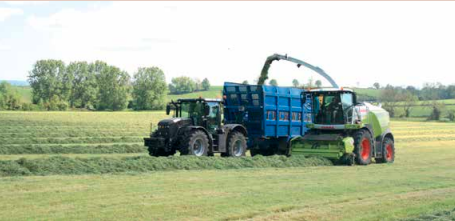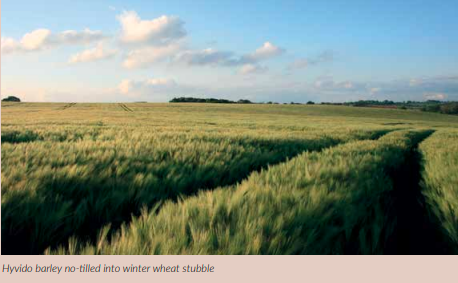There has been a bit of a backlash towards conservation agriculture methods in the media of late. Mostly from two camps of people. Those that are afraid of trying it and those that are afraid we might succeed….

When we first started our journey into no-till I was a little bit worried about row spacings on our drill. Most notill drills run at what I perceived to be wide spacings. We moved from a row spacing of 125mm too 250mm on our Primewest drill. It’s a fair increase in bare ground between rows and every man and his dog told me that blackgrass would be a problem between rows. To counter the spacing quandary we used varieties that produce more tillers. The winter barley is all a hybrid called Libra and the winter wheat is a high protein variety called Nelson which has shown good tiller numbers in trials. I’m very happy with the way both crops have filled in between the rows and due to the lower disturbance from using wider rows I believe the blackgrass is reduced rather than increased. I’m slowly working through the list of so-called problems with no-till that don’t actually exist.
The winter crops have come out of a very dry spring looking an absolute picture. Disease levels are very low in all crops and the plants look healthy. We put a little foliar feed and bio stimulant on with every fungicide pass on the winter crops which may have helped them in the dry periods. I haven’t done any areas without the foliar feed to judge the difference, which in hindsight I wish I had of done. The levels of blackgrass are visibly reduced on the no till land. The small areas of tillage that we carried out, stick out like a sore thumb. In one field we had to cultivate a corner of the field due to compaction.

You can see to the line where we ran the cultivator as that is where the black grass has taken a hold. I’m sure everyone will tell me that its because it was previously compacted that the blackgrass is there rather than the establishment technique. In the last edition of Direct Driller, I wrote about our winter beans that we had written off due too rook damage. I had given up on the crop with no visible plants three months after planting. We had another look at the field at the end of February and we discovered that the beans had started to poke through the surface again. After digging a few up, it was clear to see that the beans had put up two shoots that the birds had eaten, then they had waited through the winter and put up a third shoot in February which the birds haven’t touched. We decided to keep the beans rather than re-drill. The canopy is not as thick as I would like but we certainly have a crop to take to harvest and it will be very interesting to see how they perform.

We have around 150ha of land dedicated to spring crops this year which we have decided to sow with Spring Oats. Oats do well on our clays and if they don’t make the milling grade, we can always feed them to the cattle. We use all the straw from the oat crop for bedding which helps as I’ve heard oat residue can cause a few issues in no till fields. Half the oats were drilled into the previous volunteer cereal crops which was sprayed off at the beginning of winter, the other half had a multi species cover crop on them which was kept through till spring and terminated just prior to the drill going into the field. We have noticed that the fields with a cover crop on them over the winter have held the oat crop back somewhat. The only explanation that I can put together is that the cover crop had taken a lot of moisture out of the soil and being a dry year that had held the following cash crop behind. Next Year we may well terminate cover crops a lot earlier than we have this year or maybe have a few more winter killed species in the mix. After seeing some great results on twitter we may well roll the cover crops in a hard frost to kill them.
First cut of silage has been clamped in good time this year. The main block of silage had been rejuvenated with some diploid and tetraploid grasses last autumn which seems to have established really well between the existing thatch. The grass yields are down, but that is to be expected with the dry weather we have had. The quality looks very good though and it will be interesting to see how the feed analysis come back when we open the clamp up.

Silage machinery seems to get bigger and bigger and it can sometimes be a bit of a worry around forage season when keeping compaction to a minimum is high up the list of priorities. We use a local contractor for all our clamped forage who takes soil compaction very seriously within his business. Low ground pressure tyres, steering axles, good drivers and modern equipment all come together to help reduce the risk of damaged grass leys…. Its also great for some tractor porn as his fleet is something to behold!

I can’t wait to harvest our first full year of no-tilled crops, I don’t want to speak too soon but I don’t think we will be seeing the huge yield reduction that everyone has promised me, let’s hope the weather gods are with us come July.
